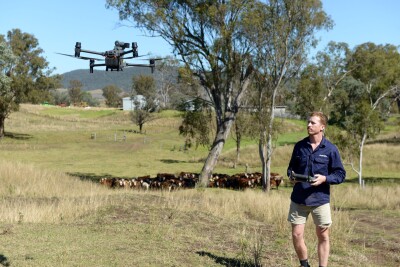While in general terms legislators seem to be trying to keep drones and airplanes apart, in Europe different projects under the Single European Sky explore the viability of simultaneous flight of civil drones and manned aircrafts.
A total of nine different projects in Europe evaluate the impact of drone integration into unrestricted airspace. The aim is to have both aircraft and drones operating in the same areas, under the same rules.One of the first simultaneous flight of a civil drone and a manned aircraft in Europe happened recently at the Spanish airport of Villacarrillo (Jaen), as part of a program which is the future technological pillar of the Single European Sky.The European ARIADNA consortium led by Indra and integrated by CRIDA, ENAIRE and Fada-Catec has completed the first simultaneous flight tests in a conventional airport of a drone or remotely piloted aircraft (RPAS/UAS) in the presence of a manned aircraft. The experience, one of the first of this kind undertaken in Europe, aims to demonstrate the viability of having drones operating in the area of the traffic of a conventional aerodrome. The European ARIADNA project thus allows further progress in integrating these aircrafts in non-segregated airspace, i.e. in the same space used by manned aircrafts.The flight program was held at the ATLAS Experimental Flight Center, located in Villacarrillo (Jaen), where the airspace that can be segregated for such operations. According to the information provided by ARIADNA, the exercises were carried out in two distinct phases. In the first, a drone, called Viewer, flew executing various manoeuvres on the airfield while the Indra MRI P2006T manned aircraft operated simultaneously.A controller supervised the operation, as in a real situation, giving separation instructions to the aircrafts. The drone's remote pilot, who monitors the aircraft from the ground at all times, had the position data of both aircrafts provided by an ADS-B receptor, thus improving situational awareness of traffic in the area. Unmanned Aircrafts and ATCAnother drone was used in the second phase of flights — the unmanned helicopter Logo— with which the feasibility of instrument approach and landing procedures with vertical guidance based on satellite navigation was validated. The ability of these aircrafts to operate at an airport under the same conditions as other aircrafts was thus demonstrated. Success in tests is a very important step for the members of the ARIADNA project, which are positioned at the forefront in the area of research and development for integration these aircrafts in the air traffic control environment.The project is one of nine co-funded by the SESAR Joint Undertaking aimed at safely integrating drones into the European ATM system. SESAR (Single European Sky Air Traffic Management Research) was set up to modernize and harmonize ATM systems through the definition, development and deployment of innovative technological and operational solutions.The ARIADNA project has been developed by a consortium of companies and institutions in the Spanish aeronautical sector, composed of Indra as coordinator and industrial partner of RPAs; ENAIRE as manager of Air Navigation in Spain; CRIDA, as a research center in air traffic management; and FADA-CATEC, as a research center and RPAs operator. One Europe, One SkySESAR (Single European Sky Air Traffic Management Research) is also involved with the trials to demonstrate safe drone integration in conventional traffic, led by Italy and Malta. The RAID (RPAS ATM Integration Demonstration), is conducting a flight trial campaign to evaluate the impact of drone integration into unrestricted airspace. The trials follow a successful series of real-time simulations (RTS), which have received positive feedback from stakeholders.According to the information available from SESAR, “RAID is one of several demonstration project co-funded by the SESAR Joint Undertaking aimed at the safe integration of civil remotely aircraft systems (RPAS). Led by CIRA, the Italian Aerospace Research Centre, the project aims to demonstrate and evaluate the impact of integrating drones into unrestricted airspace within current air traffic management environments.”The project is specifically looking at the short-term implications of such activities through real-time simulations and flight tests. The RTS were conducted in March 2015 using CIRA’s RPAS ground simulation facility and ATC simulators owned by Malta Air Traffic Services (MATS) and the University of Malta, using licensed air traffic controllers, as well as, RPAS and pseudo pilots. The results of RTS phase were presented in the first workshop held at the Italian Military Airforce headquarters on 10 December 2015. Testing Safety and SecurityThe project also recently launched a flight trial campaign using the CIRA experimental vehicle FLARE, an optionally piloted vehicle developed by CIRA on a Tecnam P92 Echos-S vehicle. Both manned and unmanned aircraft are also involved in the trials. During the trials, a number of evaluations are being carried out by the team, notably with regards human, safety and security factors in different operating scenarios. Specifically, the trials are evaluating:
One Europe, One SkySESAR (Single European Sky Air Traffic Management Research) is also involved with the trials to demonstrate safe drone integration in conventional traffic, led by Italy and Malta. The RAID (RPAS ATM Integration Demonstration), is conducting a flight trial campaign to evaluate the impact of drone integration into unrestricted airspace. The trials follow a successful series of real-time simulations (RTS), which have received positive feedback from stakeholders.According to the information available from SESAR, “RAID is one of several demonstration project co-funded by the SESAR Joint Undertaking aimed at the safe integration of civil remotely aircraft systems (RPAS). Led by CIRA, the Italian Aerospace Research Centre, the project aims to demonstrate and evaluate the impact of integrating drones into unrestricted airspace within current air traffic management environments.”The project is specifically looking at the short-term implications of such activities through real-time simulations and flight tests. The RTS were conducted in March 2015 using CIRA’s RPAS ground simulation facility and ATC simulators owned by Malta Air Traffic Services (MATS) and the University of Malta, using licensed air traffic controllers, as well as, RPAS and pseudo pilots. The results of RTS phase were presented in the first workshop held at the Italian Military Airforce headquarters on 10 December 2015. Testing Safety and SecurityThe project also recently launched a flight trial campaign using the CIRA experimental vehicle FLARE, an optionally piloted vehicle developed by CIRA on a Tecnam P92 Echos-S vehicle. Both manned and unmanned aircraft are also involved in the trials. During the trials, a number of evaluations are being carried out by the team, notably with regards human, safety and security factors in different operating scenarios. Specifically, the trials are evaluating:- Fully automated and augmented autopilot modes;
- Traffic separation managed by air traffic controllers dealing with manned and unmanned intruders;
- Emergency conditions management during jamming/spoofing of the command and control Link;
















Comments